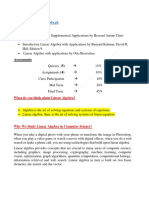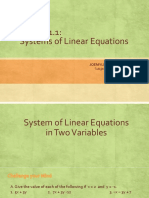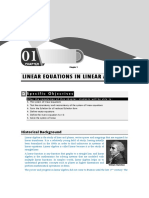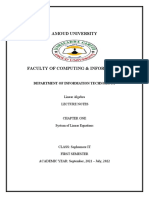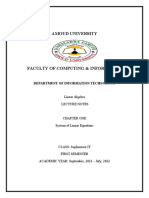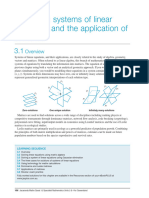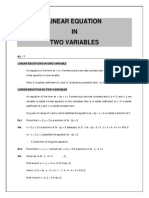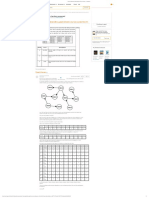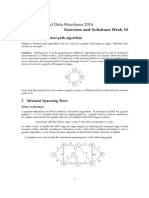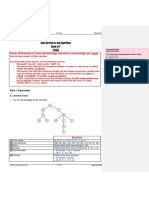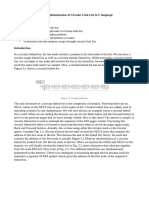Instructor: Aniqa Ahmad
Email: aniqa.ahmad@ucp.edu.pk
Reference Books:
Linear Algebra with Supplemented Applications by Howard Anton/ Chris
Rorres, Edition 10.
Introductory Linear Algebra with Applications by Bernard Kolman, David R.
Hill, Edition 9.
Linear Algebra with applications by Otto Brestscher.
Assessments
Quizzes (5) 15%
Assignments (4) 10%
Class Participation 10%
Mid Term 20%
Final Term 45%
What do you think about Linear Algebra?
Algebra is the art of solving equations and systems of equations.
Linear algebra, then, is the art of solving system of linear equations.
Why We Study Linear Algebra in Computer Science?
When you take a digital photo with your phone or transform the image in Photoshop,
when you play a video game or watch a movie with digital effects, when you do a web
search or make a phone call, you are using technologies that build upon linear algebra.
Linear algebra provides concepts that are crucial to many areas of computer science,
including graphics, image processing, cryptography, machine learning, computer
vision, optimization, graph algorithms, quantum computation, computational biology,
information retrieval and web search. Linear algebra in turn is built on two basic
elements, the matrix and the vector.
�Deep Learning (Neural Networks)
��Some Topics of Linear Algebra:
System of Linear Equations
Matrices
Gaussian Elimination and Gaussian Jordan Method
Cryptography
Matrix Transformation
Vector Spaces
Eigen Values and Eigen Vectors
Chapter 1 Linear Equation
An equation whose exponent or power is one is called linear equation.
Examples:
1. 2𝑥 + 1 = 0 One Variable
2. 𝑥 + 3𝑦 = 7 Two Variables
1
3. 𝑥 − 𝑦 + 3𝑧 = −1 Three Variables
2
4. 𝑥1 − 2𝑥2 − 3𝑥3 + 𝑥4 = ln 2 Four Variables
5. 𝑥1 + 𝑥2 + 𝑥3 + ⋯ + 𝑥𝑛 = 1 n Variables
�Linear equation does not involve any products or roots of variables. All variables occur
only to the first power and do not appear as arguments of trigonometric, logarithmic,
or exponential functions.
Linear Equation in General
The equation
𝑎1 𝑥1 + 𝑎2 𝑥2 + 𝑎3 𝑥3 + ⋯ + 𝑎𝑛 𝑥𝑛 = 𝑏 (1)
which expresses the real quantity b in terms of the unknowns 𝑥1 , 𝑥2 , 𝑥3 , … , 𝑥𝑛 and the
real constants 𝑎1 , 𝑎2 , 𝑎3 , … , 𝑎𝑛 is called a linear equation.
Q. The following equations are not linear equations. Which term in each equation is
making it nonlinear?
1. 𝑥 + 3𝑦 2 = 4
2. 3𝑥 + 2𝑦 − 𝑥𝑦 = 5
3. sin 𝑥 + 𝑦 = 0
4. √𝑥1 + 𝑥2 + 𝑥3 = 1
5. 3𝑥 + 2𝑦 = cos 2
Exercise 1.1 [Elementary Linear Algebra with Applications by Howard Anton]
1. In each part, determine whether the equation is linear in 𝑥1 , 𝑥2 and 𝑥3.
a) 𝑥1 + 5𝑥2 − √2𝑥3 = 1
b) 𝑥1 + 3𝑥2 + 𝑥1 𝑥3 = 2
c) 𝑥1−2 + 𝑥2 + 8𝑥3 = 5
d) 𝑥1 = −7𝑥2 + 3𝑥3
3
5
e) 𝑥1 − 2𝑥2 + 𝑥3 = 4
f) 𝑥1 − 7𝑥2 + ln 𝑥3 = 1
�Solution of a Linear Equation
A solution to Linear Equation (1) is a sequence of 𝑛 numbers 𝑠1 , 𝑠2 , … , 𝑠𝑛
which has the property that (I) is satisfied when 𝑥1 = 𝑠1 , 𝑥2 = 𝑠2 , … , 𝑥𝑛 = 𝑠𝑛 are
substituted in (1).
For example: The equation 6𝑥1 − 3𝑥2 + 4𝑥3 = −13
has the solution
𝑥1 = 2, 𝑥2 = 3, 𝑥3 = −4
Because on substituting these values, equation becomes identity i.e;
6(2) − 3(3) + 4(−4) = −13
or −13 = −13
System of Linear Equation in two Variables
A system of linear equations in two variables 𝑥 and 𝑦 will have the form
𝑎 𝑥 + 𝑏1 𝑦 = 𝑐1
{ 1
𝑎2 𝑥 + 𝑏2 𝑦 = 𝑐2
Here 𝑎𝑖 , 𝑏𝑖 , 𝑐𝑖 (𝑖 = 1, 2) are real numbers.
To find a solution to a linear system, we already know two techniques called the
1. method of elimination
2. method of substitution
3. We are going to learn new systematic techniques for complex systems.
Note! Solution from any of these methods will remain same.
Example 1 Find the solution of the linear system by using method of elimination.
5𝑥 + 𝑦 = 3
2𝑥 − 𝑦 = 4
Solution
We want to eliminate y, so by adding both equations we get:
7𝑥 = 7 ⇒ 𝑥 = 1
�Put value of 𝑥 = 1 in first equation
5(1) + 𝑦 = 3 ⇒ 𝑦 = −2
So (1, -2) is solution of the given system.
Example 2 Find the solution of the linear system by using method of elimination.
𝑥 − 3𝑦 = −7 (1)
2𝑥 − 6𝑦 = 7 (2)
Solution
We want to eliminate x, so by multiplying equation (1) by ``2’’ and subtracting from
(2), we get
2𝑥 − 6𝑦 = −14
−2𝑥 + 6𝑦 = −7
−−−−−−−−−−−−
0 = −21
which makes no sense. This means that the given system has no solution.
Consistent and Inconsistent Linear System
If the linear system has no solution, it is said to be inconsistent, if it has a solution. it
is called consistent.
So the system in example 1 is consistent and in example 2 is inconsistent.
Note!
A consistent linear system of two equations in two unknowns has either one solution
or infinitely many solutions--there are no other possibilities.
7. In each part, determine whether the given point is a solution of the linear system
2𝑥 − 4𝑦 − 𝑧 = 1
{ 𝑥 − 3𝑦 + 𝑧 = 1
3𝑥 − 5𝑦 − 3𝑧 = 1
a) (3, 1, 1)
b) (3, -1, 1)
c) (13, 5, 2)
� 13 5
d) ( , , 2)
2 2
e) (17, 7, 5)
8. In each part, determine whether the given point is a solution of the linear system
𝑥 + 2𝑦 − 2𝑧 = 3
{ 3𝑥 − 𝑦 + 𝑧 = 1
−𝑥 + 5𝑦 − 5𝑧 = 5
5 8
a) ( , , 1)
7 7
5 8
b) ( , , 0)
7 7
c) (5, 8, 1)
5 10 2
d) ( , , )
7 7 7
5 22
e) ( , , 2)
7 7
11.
Work to do:
Exercise 1.1 Q 1-10

